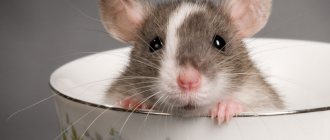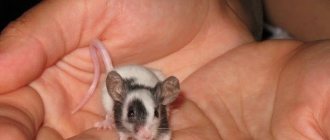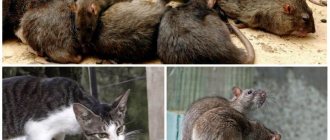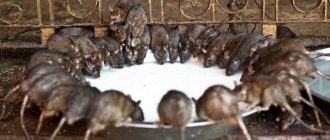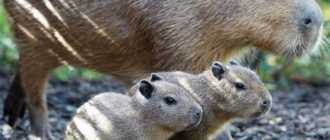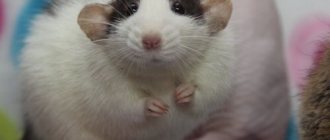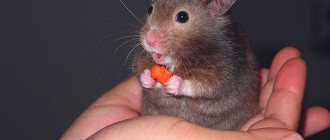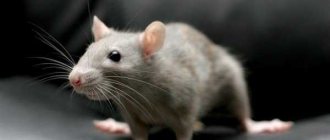What determines the size and weight of rats?
The body weight and size of a rodent depends on several factors:
- The species to which the animal belongs. For example, small rats (Rattus exulans) weigh about 70 g and are only 14 cm long. But pasyuks, which are familiar to humans, grow to 20-25 cm and gain a weight of 200-390 g.
- Gender of the rodent. Males, both in nature and among ornamental representatives of this species, are approximately 10-15% larger than females.
- Hereditary data. If the cub's parents are small, then it is unlikely that it will grow into a large rat. This also works in the opposite direction. In large individuals, the appearance of small offspring indicates some kind of pathology or unfavorable factors during the female’s pregnancy.
- Food and living conditions. The ability to obtain adequate nutrition directly affects how much a rat will weigh. If during pregnancy the female does not receive adequate food, the offspring will be more frail. Vitamin and mineral deficiencies during infancy also affect adult size. The animal will be weak and noticeably smaller than its fellows.
- A calm, comfortable environment has a beneficial effect on the weight of animals. A state of constant stress can inhibit development in small rodents.
- Health. The size of an adult rat is directly related to the condition of its body. Of course, it will not become larger than the parameters assigned to it by nature, but excessive thinness and weight loss are direct evidence of an illness in the animal.
Homemade
Measuring the mass of a rodent is simple; just place it on some sensitive scale. Kitchen ones are also suitable. But there are problems with measuring length. The plastic structure allows them to both stretch the body and compress it. The difference in numbers will be colossal.
How to distinguish old animals from young individuals?
Pet rats can live up to 3 years, but for most of that time they do not change their appearance.
This is one of the reasons why it is not recommended to buy an adult rat, but instead look for young rats that are approximately 6 weeks old. Not only is an adult rat more difficult to socialize, but they may not live long, which can be heartbreaking, especially if this is your first pet rat. Typically, the following factors indicate the age of an animal:
Rat teeth color
When a rat's teeth appear, they have a yellow tint. However, over time they become a little darker and the teeth turn orange in old age.
However, it is possible that you have found a rat with natural orange teeth rather than a rat whose life is coming to an end. But think twice before picking up a rat with orange teeth, as it may leave you too soon.
A rat's diet and general health can also affect the coloration of its teeth, and even a young rat may have orange teeth under certain circumstances.
Rat fur quality
Rats are quite finicky animals; they like to be clean and well-groomed. This means that you can often tell how old a rat is by the condition of its fur.
If it has a smooth, silky coat that looks shiny and beautiful and is mostly even in length, the rat is probably less than 6 months old (or possibly 9 months old for females).
As rats mature, they go through the equivalent of puberty. Their fur becomes coarser and less silky, and this occurs more dramatically in male rats than in female rats. In old rats, that is, older than 18 months, the fur may be coarse or absent.
If a rat has orange teeth and its fur is in poor condition, it can be assumed that the animal is at retirement age.
The largest and smallest rats in the wild
Species of rats differ among themselves in their habitat (some prefer to live close to humans, others far away), in size, and taste preferences. People have known some of the representatives of rodents since ancient times, and some they met quite recently.
- The giant Papuan or Bosavi woolly rat does not even have a scientific name yet. It was discovered in 2009 on the island of Papua, which belongs to the territory of New Guinea. It received its temporary name due to the crater of the Bosavi volcano, where it was discovered. Perhaps it can be considered one of the longest rats, since the size of the body reaches 1 meter, plus a tail of about 30 cm.
- Cane rats or bristle pigs are real giants. Despite the body length of 55-60 cm, the weight of females reaches 4-5 kg, and in males it can reach up to 9 kg. They live in equatorial and southern Africa.
- In Russia, the largest breed is the pasyuk or gray rat . Its body length is 17-25 cm, and its weight is 140-390 g.
- The size of the smallest rat found in the wild barely reaches 11–15 cm, weight from 40 to 80 g. The little ones live in New Guinea, the Pacific Islands, and Southeast Asia. In addition to the official name - small , they are also called Pacific or Polynesian .
Children's legends about mutant rodents that appeared due to environmental problems do not have any supporting facts.
More about huge mutant rats
Yet stories of giant mutant rats in the Moscow metro or abandoned military bunkers remain surprisingly enduring. Their phenomenon is easy to explain: people do not want to put up with the dullness of their everyday lives and are willing to believe in almost any unusual and inexplicable phenomena, even frightening ones. After all, these “horror stories” give hope that the world around is not as ordinary and dull as it seems most of the time, and there is certainly a place in it for some mysteries - including mutant rats.
It is also useful to read: Interesting facts about gray rats (pasyuki)
Simply put, people want to believe in the existence of monster rats, and science fiction writers, horror film directors, and rumor mongers simply exploit these fears to their advantage. As a result, more and more new versions of “facts” and “eyewitness accounts” constantly appear, and the old ones are repeatedly altered and turned into more and more new versions, sometimes completely different from the originals.
For example, the stories allegedly told by Moscow metro drivers are very well known. According to them, in the farthest sections of the tunnels, the headlights of trains occasionally reveal huge rats the size of dogs crossing the tracks. Most of these stories are full of chilling details: in that brief moment that a ray of light snatches a rat from the darkness of the tunnel, the animal manages to look at the driver with evil green (in other versions - red) eyes, and then suddenly news appears that these animals no poison works. It is unknown which of the drivers tried to poison these mutants (just as the names of those who actually saw these animals are not known), but most storytellers consider it their duty to mention such immunity.
Also popular is an allegedly real story that happened to a group of Moscow diggers (specialists involved in the study of caves and artificial underground tunnels). In a sewer under the zoo, this team was attacked by five large rats the size of a dog, and the guys were saved only by throwing their crowbars at the animals and in this way scared them away.
This story was continued. They say that an anonymous person later called the diggers club and said that there were a lot of large rats in secret bunkers for storing radioactive waste. It is well known that the more secrecy and conspiracy theories there are in a story, the more popularity it will have...
There are also stories circulating among people about giant rats climbing out of manholes near landfills and scattering dogs there. Moreover, these stories are unusually tenacious: the first reports of such rats appeared back in 1989, and after that their number has only increased.
It is interesting to note that the less believable each particular story is, the more easily it spreads among the people. It is the details that seem fantastic that make such tales “hot”: either huge rats create the most complex organizations with commanders, pioneers and suicide bombers, or they deliberately feed on poisons or winding wires - there are countless such details.
Someone is even trying to mix together rumors about mutant rats and news about the discovery of Bosavi woolly rats. The result is a mix unimaginable for a specialist that, they say, scientists have discovered a new species of giant rats - Indonesian - in the Moscow subway. Why Indonesian? Simply because the name is simpler than “Bosavi woolly rat” or “Papua New Guinea rat.”
We will not waste time refuting such speculation, but will only say that none of these rumors have factual confirmation.
The largest city rats
City rats are the same animals that live in rural areas. For a long time, black representatives of this family settled in the attics and basements of houses, lurked around the streets and spoiled the supplies of the townspeople, and served as a source of various diseases. In the 18th century, gray rats began to spread from port cities throughout Europe. Larger, aggressive, eating not only grain reserves, but also meat products, they became a disaster.
A big street rat could drag away a chicken, attack a small child, and, driven into a dead end, bravely fought with cats and dogs. Gradually displacing black rats, pasyuks began to spread throughout all the countries where people live. The most important thing for these animals is the availability of water and food. The only place they avoid is heights. It is almost impossible to meet them on the upper floors of skyscrapers. That's why there are still black rats there, which prefer dry attics. The native element for gray rodents is basements, communications, metro lines, sewers.
Wild animal
Any measures to destroy pasyuks only temporarily reduce their colonies. Smart animals with a clearly constructed hierarchy and defined roles within the group never risk the entire flock. They quickly learn to avoid any human traps and can temporarily leave dangerous territory. But as soon as the colony grows, everything will return to normal.
Rodent squad: general characteristics and features
The closest relatives are rabbits and hares, forming the order Lagomorpha.
Features of the structure:
- Teeth. Distinctive features are the long upper and lower pairs of incisors, which do not have roots and grow throughout the animal's life. Elongated incisors are needed for gnawing hard food.
- Dimensions. Most representatives of mammals are small in size: from 5 cm to 50 cm. The exception is the largest representative of the species - the capybara, whose length reaches 130 cm, weight up to 91 kg.
- Skeleton. Features of the skeleton are a stocky build, hind legs longer than the front, and a long tail. The tail of some individuals may be significantly longer than the body.
- Digestion. Due to feeding on rough plant foods, rodents have long intestines. They have a cecum, where food is processed through fermentation.
This type of mammal is not whimsical and does not require special knowledge or skills in care, so rodents are often chosen as pets.
Features of care:
- Housing. It must be remembered that most rodents are active animals. The cage should be spacious and kept clean. Removal of food debris and washing of the sippy cup is carried out daily. Cleaning the floor and cleaning the litter - once a week. Once a month you need to disinfect the cage.
- Dental care. There should always be wooden sticks in the cage so that the pet can grind his teeth, which are constantly growing, on them.
- The washing up. You need to place a container with fine sand in the cage so that the animal can clean its fur.
- Situation. Rodents are shy and sensitive creatures, so housing, if possible, should be located in a secluded place, protected from the hustle and bustle.
The numerous species of rodents make their classification extensive. The rodent order has 5 suborders:
- protein-like;
- mouse-like;
- porcupines;
- spiny-tailed;
- beaver-like
Classification: more about suborders
- Squirrel-like. Members of the suborder include squirrels, chipmunks, marmots, and flying squirrels. They live mainly in forests, have strong muscles of the lower jaw, this allows them to gnaw and break solid food. Most representatives of the suborder are omnivores.
- Mouse-like. You can most often meet representatives of this family in everyday life. These include mice, rats, hamsters, voles, lemmings, jerboas, and muskrats. Most of them are nocturnal and feed on seeds and grains.
- Porcupines. The group includes agouti, porcupines, mole rats, nutria, chinchillas, and capybaras. Most representatives of this class are large species with a heavy, rather awkward physique. They are characterized by modified hair into coarse bristles or needles.
- Spiny-tailed. There are nine species, including spiny-tailed squirrels, Pela spinytails, long-eared spinytails, and Cape striders. These animals got their name because of their tail, which is partially devoid of fur and covered with pointed scales. Some members of this suborder, with the exception of the spiny-tailed squirrels, have flight membranes that allow them to glide.
- Beavers. There are about 100 species from 3 families: beavers, gophers and pouchhoppers. Scientists identified it as a fairly young detachment only in 2005. This class includes large rodents with cheek pouches and strong limbs.
Size and weight of pet rats
Artificially bred decorative rats are increasingly winning the love of humans. Having been born less than 70 years ago, thanks to a strict selection of producers, we managed to obtain affectionate, peace-loving and intelligent animals. Breeders, taking advantage of the rapid emergence of the next generation in these rodents, are excitedly developing new breeds.
Despite the fact that pets are all approximately the same size, there are several species with the largest rats.
- Brown. On average, the animals weigh 500-600 g, but some specimens reach 900 g. Although this cannot be called the norm. It is possible that the rodents are obese. Representatives of this species live only two years.
- Standard. One of the most common breeds. Affectionate and non-aggressive rodents rarely bite despite their very large size for an ornamental rat. They weigh up to 500 g, body length is about 30 cm.
- Dumbo. Representatives of this species were bred in California. Their large protruding ears give their faces a funny expression. The value of a breed representative is determined by the length of the ears. They grow up to 20 cm and gain a weight of about 400 g.
Giant Afghan and Pakistani rats are also a legend...
And another legend, very famous in the past, but today somewhat forgotten, is associated with supposedly large rats from Afghanistan. The essence of the story is this: in the 1980-1990s, in the era of shuttles and the fashion for exotics, smooth-haired dachshunds became very popular in Russia. And allegedly, for some owners, these dogs behaved completely out of character for the breed.
After examination by veterinarians or dog handlers, it turned out that sometimes special, very large Afghan and Pakistani rats were sold to wealthy buyers under the guise of dachshunds. They say that these rodents had large ears and were exactly the size of a small dog. But the main intrigue of these tales was that such pets had an unpredictable character and could unexpectedly attack their own owners.
In reality, this story is nothing more than an urban myth. The same rats live in Afghanistan and Pakistan as in Russia, and science does not know of such a rodent that can be confused with a dog.
Perhaps the main conclusion that can be drawn from our entire story is that you shouldn’t be afraid of some huge mutant rats. Those rodents that can be found near human habitation usually do not reach large sizes. They certainly will not attack the person himself with the aim of biting or snatching a piece of his flesh.
Yes, rats sometimes bite people, but they do this very rarely, mostly in self-defense. Indeed, large rats are rare and very peaceful; seeing them is a real success for a zoologist and an almost impossible task for an ordinary city dweller. Therefore, we can sleep peacefully, giant rats from the sewer do not threaten us.
Interesting video: a cat versus a huge rat - who will win?..
Average size of baby rats based on their age
Rats are born blind, without fur and with closed ears. Weight at birth is only 4-6 g. Thanks to the mother's nutritious milk, babies grow quickly, adding 2-3 grams every day.
Already on the 10th day of life, they hear well, are covered with fluff, and begin to actively explore the available space. Their body weight increases 6 times during this time.
After 20 days from the moment of birth, rats become similar to adults and grow to a size of about 15 cm.
On the 25th day, the babies are separated from their mother, otherwise the female will independently expel the offspring from the nest into an independent life.
Active growth of young animals continues up to 6 months, but a rat can reach its maximum size only by the age of one year.
Young animals
Approximate weight of the animal depending on age:
- Newborn – 4–6 years.
- 2 months – 160–220 g.
- 3 months – 210–310 g.
- 4 months – 250–430 g.
- 5 months – 300–540 g.
We must not forget that the given indicators are averages, according to which you do not need to adjust your pet. If the animal is active, feels great, and its fur is shiny, then there is no need to try to feed it more high-calorie food or, conversely, limit its food intake.
